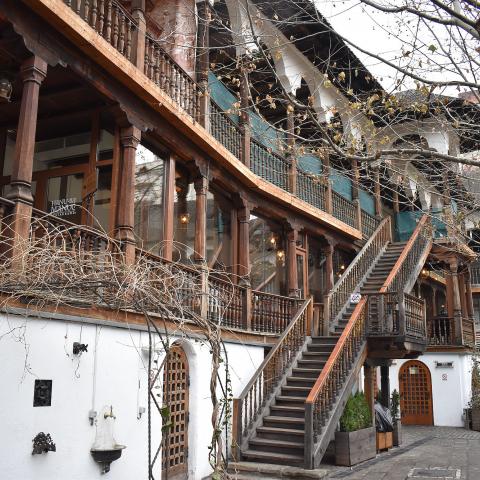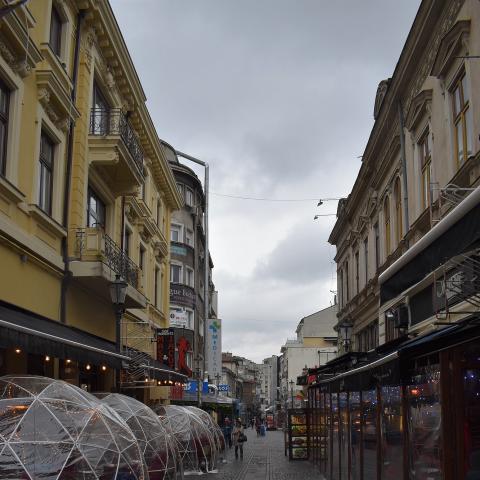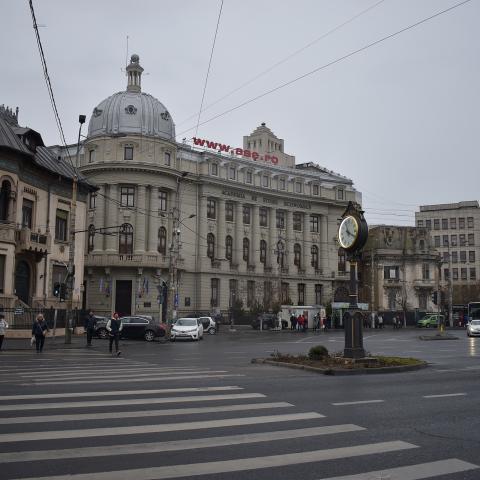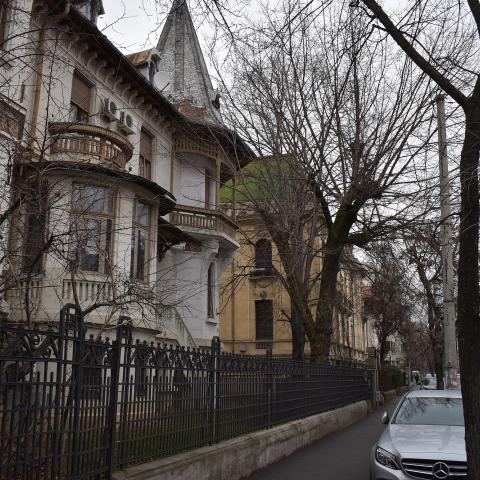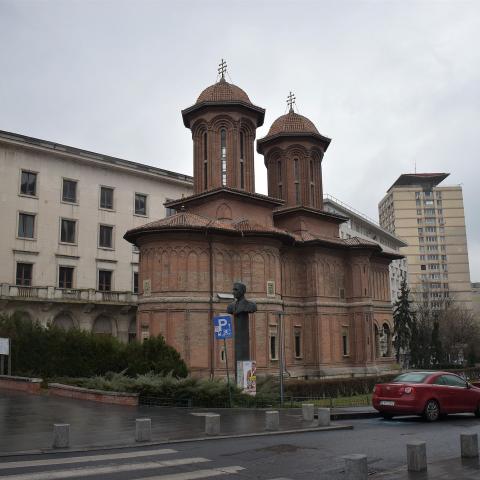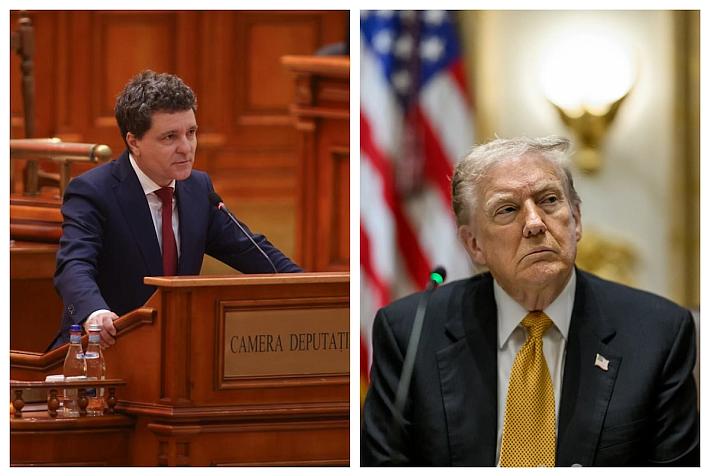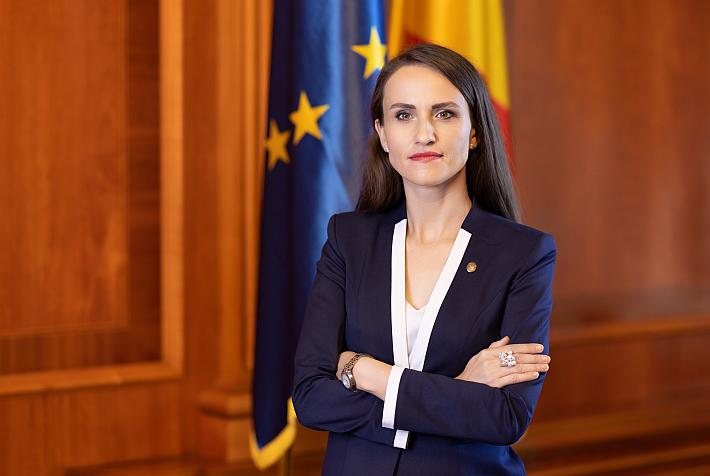"Destination Bucharest" - Must-see sites during a business trip

Marked by the need for efficiency, business trips can leave little time to explore a city. But a meeting-filled agenda does not rule out exploring the city and its main tourist attractions. We go on a walk from the north to the downtown to discover traditions, history, architectural diversity and entertainment.
In the northern part of the city, close to the Regele Mihai I Park (formerly known as Herăstrău), Dimitrie Gusti National Village Museum is a must-see to learn more about local culture and traditions. Coming from the offices area in the Charles de Gaulle Square, past the Arch of Triumph, the museum is easy to find, and the rooftops of the houses in its patrimony immediately alert of its presence. Set on the shore of the Herăstrău lake, it offers visitors the opportunity to take a stroll on the alleys of a village made up of houses, monuments and artefacts dating back from the 17th century to the beginning of the 20th century. The constructions originate from various ethnographic areas of the country and offer the possibility of seeing, in a short time, a rich and varied cultural heritage. The museum hosts many events and fairs, opportunities to get to know traditional craftsmen and their work and to discover various customs and traditions. During spring, events to watch include those dedicated to Mărțișor or the Easter celebration.
Just one subway station away from Charles de Gaulle Square (Aviatorilor subway station) is another important business area of the Capital – Victoriei Square, but also one of the ends of Calea Victoriei, one of the oldest and most beautiful arteries of the city. A walk on the boulevard that reaches Splaiul Independenței, running alongside Dâmbovița river, is the equivalent of a walk back in time, through the city’s history and some of its most beautiful architecture.
Close to Victoriei Square we find the Cantacuzino Palace, hosting the George Enescu Museum, dedicated to the Romanian composer, violinist, pianist and conductor. Built by architect Ion D. Berindey in the style of French academism, with Art Nouveau elements, it is easy to recognize by the sumptuous entrance, flanked by the statues of two lions. The exterior elegance of the edifice is reproduced on the inside and those who take the time to visit will find here a part of the atmosphere of the period when Enescu lived in Bucharest but also personal items, musical instruments or scores of the artist.
Walking further on Calea Victoriei, the buildings that are worth taking note of, even just from the outside, are not few. The building of the Romanian Academy stands inside a park with lush vegetation, from where the statue of goddess Minerva can be seen. A little further up, we find the Museum of Art Collections, housed by the Romanit Palace, a building representative for the 19th century architecture of Bucharest. The patrimony of the museum covers a wide variety of Romanian, European and oriental art donated by various collectors and artists, most of them Bucharest residents.
A further few steps away from the Art Collections Museum we reach a well known hotel, another landmark of the Capital and a well-known location for the business people who visit the city. It opened its doors in 1914, and it initially had a façade in a classical style. In 1937, it was transformed according to the plans of architect Duiliu Marcu and received the Art Deco look it has today.
Close to the hotel we find the Romanian Athenaeum, another symbol of Bucharest, the place where classical music lovers gather weekly for the program offered by the Orchestra of the George Enescu Philharmonic. The building of the Athenaeum, realised according to the plans of French architect Paul L. Albert Galleron, is easy to recognize by its look inspired by the ancient Greek temples and its pediment, supported by columns. The construction was partly funded through a public subscription, with the help of those who answered the call “Daţi un leu pentru Ateneu (Give a penny for the Athenaeum).”
A little further in front the Revolution Square awaits. Surrounded by so many impressive buildings, with an elegant architecture, attracting tourists who stop to take photos, the area was 30 years ago the setting of such violent events during the 1989 Revolution.
On one side, we find the Central University Library, housed by the palace of Carol I University Foundation, built according to the plans of French architect Paul Gottereau. The building housed a collection of rare books, maps and manuscripts belonging to personalities of Romanian culture, lost however in the fire that engulfed the edifice during the 1989 Revolution.
Across the street is the former Royal Palace, today the National Museum of Art of Romania (MNAR). The edifice is the result of the transformation, at the request of King Carol I, of the ceremonial palace built by Alexandru Ghica on the artery known as Podul Mogoşoaiei. During the events of December 1989, the palace suffered significant damage and many works were harmed or destroyed. Renovated and refurbished, it now offers visitors the occasion to see here ample collections of Romanian and European art.
In front of MNAR stands the Palace of the Interior Affairs Ministry, known before 1989 as the headquarters of the Central Committee of the Romanian Communist Party (PCR). The history of the project of the palace begins in the monarchy period, but it is most often known today as the building from whose balcony dictator Nicolae Ceaușescu held his last speech, in an attempt to pacify those who were rebelling.
The historical significance of the square is marked by several monuments, among them the Memorial of Rebirth, created by Alexandru Ghilduș, to honor the memory of the victims of the 1989 Revolution. Also in the square are the monuments of two personalities held in communist prisons: Iuliu Maniu, a former prime minister of Romania, who died as a political prisoner in the Sighet penitentiary, and Corneliu Coposu, a political prisoner during the Stalinist period of the communist regime of Romania, who re-founded the National Peasant Party after 1989.
On one side of MNAR we find the Crețulescu Church, one of the most valuable architectural monuments of the city from the end of the Brâncovenesc period. It was built between 1720 and 1722 from the initiative of chancellor Iordache Crețulescu and his wife Safta, one of the daughters of ruler Constantin Brâncoveanu.
We go further up on Calea Victoriei to the Palace of the National Military Circle, today undergoing refurbishment works, and make a right on Regina Elisabeta Boulevard in order to reach Cișmigiu Park, the oldest public garden of the city. It is set up in the style of English parks and has several entrances: from the Regina Elisabeta Boulevard, Schitu Măgureanu boulevard and Știrbei Vodă street. It is a favorite meeting place for many Bucharesters, students at the Gheorghe Lazăr High School, sitting on a corner of the park, or of the students of the Conservatory. It is also a place mentioned in many works of Romanian or international literature. Olivia Manning’s novel “The Great Fortune”, part of the Balkan Trilogy, includes several scenes that take place in Cișmigiu. A walk on its alleys can bring visitors face to face with several Romanian writers, as they are represented by the statues in the Writers’ Round, with elegant fountains and romantic landscapes, for a short break in a meeting-filled business trip. Elsewhere, Bucharest has many large parks, spread throughout its neighborhoods, attracting those who live nearby.
From Cișmigiu we go back to Calea Victoriei and take a short coffee break on Lipscani Street. Bucharest has many coffee shops serving specialty coffee, in the most creative of settings. These are often the favorite meeting places or work venues for young entrepreneurs and creatives.
We cross Calea Victoriei and continue on Lipscani to reach the Old Town, an unmissable spot in any visit, no matter how short, in the Capital.
Bordered by Lipscani and Stavropoleos streets we find a special restaurant, a landmark of the historic center and a place where tourists can sample traditional Romanian food. The place has a history going back more than 130 years as well as an impressive architecture. The building was erected in a Neo-Gothic style, according to the plans of architects Zigfrid Z. Kofczinski and Al. Pesch, and is decorated with numerous paintings, stained glass, mosaics and sculpted paneling. The restaurant is always in demand so prior reservation is recommended.
Nearby, we spot the Stavropoleos Church. The Old Town is known for the high density of restaurants, bars, terraces, cafes and clubs, being a place of leisure and entertainment. The presence of the church in the middle of all the hustle and bustle is even more impressive, and an occasion, for those visiting the area, to see a part of the city’s patrimony of religious architecture.
The church was built in the Brâncovenesc style, in 1724, by archimandrite Ioanichie Stratonikeas. He erected the church in the courtyard of his inn. The inn and the church annexes were demolished at the end of the 19th century but the church, restored, can still be visited.
We walk further on Stravopoleos street, take a turn on Lipscani and reach the intersection with Smârdan street, on one side of the palace of the National Bank of Romania, described by architect Ion Mincu as “the most beautiful building in Bucharest.” Here, the Museum of the National Bank of Romania is set up. Across the street is another impressive building, whose details take time to discover. It is the Dacia Palace, where the Bucharest Pinacothèque is set to open. At the crossroads, a young man is playing Oasis’s Wonderwall on the guitar. He has a microphone and the instrument’s case is open, for the passersby who want to reward him.
We go further down on Lipscani, on a cold February day. The terraces are covered in plastic protections and those who stop by can enjoy, even at lower temperatures, the site of the narrow streets of the Old Town, bordered by former inns or houses built, many of them, in the 19th century. Some of the restaurants take the idea of the terraces available regardless of the season one step further and offer individually-covered tables, looking like plastic igloos.
Another few steps and we are in front of the elegant edifice hosting one of the most beautiful bookstores in the city. The library’s offer includes many English-language titles but also volumes in English, French or German covering the history and culture of Romania and of the city. Beyond the book offer, the library is worth a visit for its interior architecture, with terraces undulating elegantly around the atrium and a transparent ceiling allowing for light and shadow effects throughout the day.
We leave the library behind, enter Șelari street, then Covaci and reach another landmark of the Old Town – Manuc’s Inn. Many of the streets in the area carry the names of merchants who undertook their activities there: Lipscani takes its name from the sellers who brought on local markets merchandise from Lipsca (Leipzig); Covaci- from the Hungarian term kovács (covaci), a blacksmith; while Șelari from those who manufactured and sold saddles and other related gear. They are all a reminder this is where the old commercial center of the city and the old princely court once stood.
The inn was built on a plot of land that used to be part of the Old Court, purchased by the inn’s owner Manuc Mârzaian, also known as Manuc Bei. He was an Armenian merchant and diplomat, who had moved to the Romanian provinces of the beginning of the 19th century. The construction works started around 1806 and the inn turned into a meeting and rest place for traders and travelers of all nationalities.
It is one of the few inns still standing from the almost 40 that existed in Bucharest two centuries ago. A visit to its interior courtyard reveals the verandah and the wooden decorations and elements and raises at least one question: how is it that, seen from an exterior side, the inn seems to have a ground floor and an upper floor, and from the inside, a ground floor and two levels? A very popular restaurant can also be found on site. It serves traditional local dishes, another reason to make a stop here.
Leaving the inn, we immediately notice the St Anton Church of the Old Princely Court, the oldest medieval monument in the city. In between 1459 and 1660, the rulers of Wallachia used Bucharest as a residence, concomitantly with the old capital in Târgovişte. After 1660, it remained the sole capital. The Old Court is currently closed for restoration works but the St Anton Church, built on the site of an older, wooden one, which served as a chapel for the Princely Court, can still be visited.
We walk further on Franceză Street, enter Căldărari and we find ourselves in Unirii Square, one of the busiest and most transited areas of the city. We cross the Dâmbovița river, head towards Mitropoliei Hill and right away we are faced with the sight of one of the city’s newest tourist attractions – the building of the Parliament Palace. The colossal project initiated by dictator Nicolae Ceaușescu, the building impresses with its size and holds several records for surface, volume and the costs involved for its construction. An appointment is needed to visit the building and the visitors’ entrance is on one side of the Izvor Park. Those who do not have time for a visit can get an idea of the size of the building by taking a short walk to Constituției Square and the surrounding area.
From Unirii Square we take the subway to Romană Square, another very busy area, from where Dacia Boulevard starts. It is one of the city’s most beautiful arteries and one of the best to see in order to discover Bucharest’s architectural diversity. Initially a residential area, today it hosts numerous embassies and crosses an area where many creative entrepreneurs work. The villas and blocks dotting the boulevard are a mix of styles – Art Deco, neo-Romanian, Neoclassical or eclectic – and many buildings have a small plaque indicating their historical monument status, alongside explanations about the name and the architectural style they were built it.
The walk can go on or not, but we have seen and learned more about the identity of the city, beyond the glass-covered office buildings that fill the capital’s business areas.
This material is part of a project under the program of promoting the touristic heritage "Destination: Bucharest", carried out by the Bucharest City Hall through the Public Monuments and Touristic Heritage Administration (AMPT).
Photos by Romania-Insider.com for AMPT.












